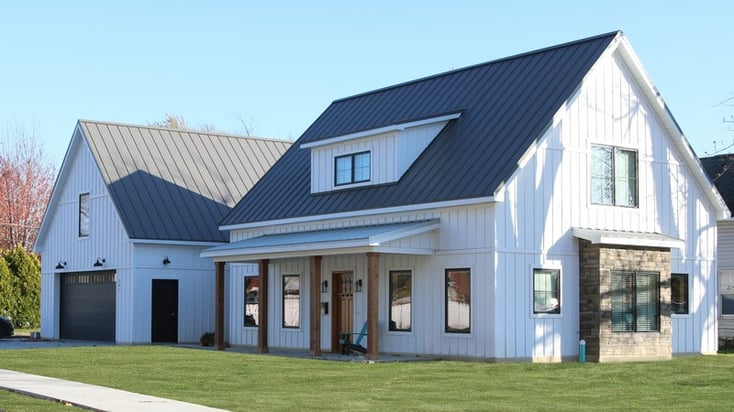Many homeowners are forgoing traditional stick-built construction and taking advantage of the benefits of post-frame construction methods. The term “post frame” may not be familiar to you, but it’s likely that you’ve encountered a post-frame building before.
Post-frame buildings, also referred to as “pole barns”, are commonly used for storage, utility, and hobby buildings. Perhaps you’ve enjoyed a leisurely drive across country roads and noticed a variety of barns and agricultural storage buildings. Post-frame construction is common in agricultural and commercial projects, but the construction method is also gaining popularity in residential use for a variety of reasons.

First, let’s start by defining exactly what post-frame construction is and how it differs from traditional, stick frame construction.
Stick frame construction is what comes to mind when most people think of traditional home building methods. Framing of the building is constructed using wood studs or structural steel and is generally built on top of a concrete slab, basement, or crawlspace foundation. The frame of the building is typically constructed with studs and trusses every 16” to 24” on-center, and it uses interior walls for structural support.
Post-frame construction uses large posts or laminated columns, and trusses to transfer its load into the ground. Posts or columns are typically buried 4-6 feet into the ground to maximize strength and support. Posts or columns are spaced 8’ on center and roof trusses are spaced 2’ to 8’ on center depending on load requirements and desired interior finishes. Therefore, post frame buildings do not need interior load-bearing walls. This is how they accomplish their vast open interior spaces that are well suited for agricultural, commercial, and even residential projects.
Now that we’ve identified the differences between stick frame and post-frame construction methods, let’s discuss the unique benefits a post frame home can offer.
Speed
Post-frame construction is a popular choice because it is often more quickly erected than other types of buildings. Traditional stick-built homes have extensive framing work, so the process is time-consuming. Post-frame buildings often feature metal and roofing siding which are also installed quickly.
Energy Efficiency
Structural posts or columns in a post frame home are typically 8’ on-center whereas stick frame homes have studs located every 16” to 24.” Due to the depth of the post or column, post frame buildings have a larger wall cavity that allows for more insulation and improved thermal performance. While insulation costs may be higher on your project, homeowners have the potential to reap the long-time benefit of lowered heating and cooling costs.
Labor and Material savings
Post-frame buildings are designed to be erected simply and quickly. The framing system may be designed with extra material to handle greater loads than stick-built construction, reducing time, labor, and material costs.
Design Aesthetics
Selecting a post-frame home does not mean sacrificing design or aesthetics. Buildings can be designed utilizing various exterior options, including brick, steel, stucco, or stone. However, the most popular exterior design application for post-frame homes is steel panels. Metal wall panels provide a wide variety of options for homeowners to consider, including multiple rib patterns, vast color palettes, and different panel orientation options. Additionally, homeowners enjoy that metal wall panels often require very little maintenance.
Wide Open Spaces
Without the need for interior support walls, post-frame homes lend themselves to open living concepts. Larger frame spacings created by 8’ post spacing dramatically improves design options. Homeowners and designers can easily incorporate openings for larger or custom windows and doors. Design flexibility makes post-frame homes ideal for waterfront views, cabin retreats, or just about any homeowner who wants to take in a full view of the outdoors.
Next Steps
Before making all your post-frame dreams come true, homeowners must research the obstacles they may encounter when pursuing a post-frame home project. For instance, some banking institutions have different parameters for post-frame structures. Or perhaps your county or parish does not issue permits for residential post-frame projects.
Before getting too far into your project, you will want to research any potential setbacks. Your local post-frame contractor can be a great source for information and knowledge regarding local codes, financing, and ordinances.
A post-frame home is an option worth exploring for those looking to construct their next home. And while post-frame construction is traditionally used in agricultural and commercial projects, it has much to offer for residential use.
About McElroy Metal
Since 1963, McElroy Metal has served the construction industry with quality products and excellent customer service. The employee-owned components manufacturer is headquartered in Bossier City, La., and has 14 manufacturing facilities across the United States. Quality, service and performance have been the cornerstone of McElroy Metal’s business philosophy and have contributed to the success of the company through the years. As a preferred service provider, these values will continue to be at the forefront of McElroy Metal’s model along with a strong focus on the customer.









Comments on this article:
Scroll down to the bottom to submit a comment and join the conversation. Need help or have a question? Please contact us. Looking for a distributor or contractor? Please click here to get started.